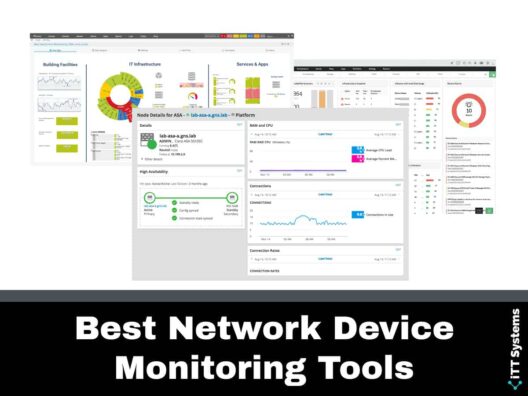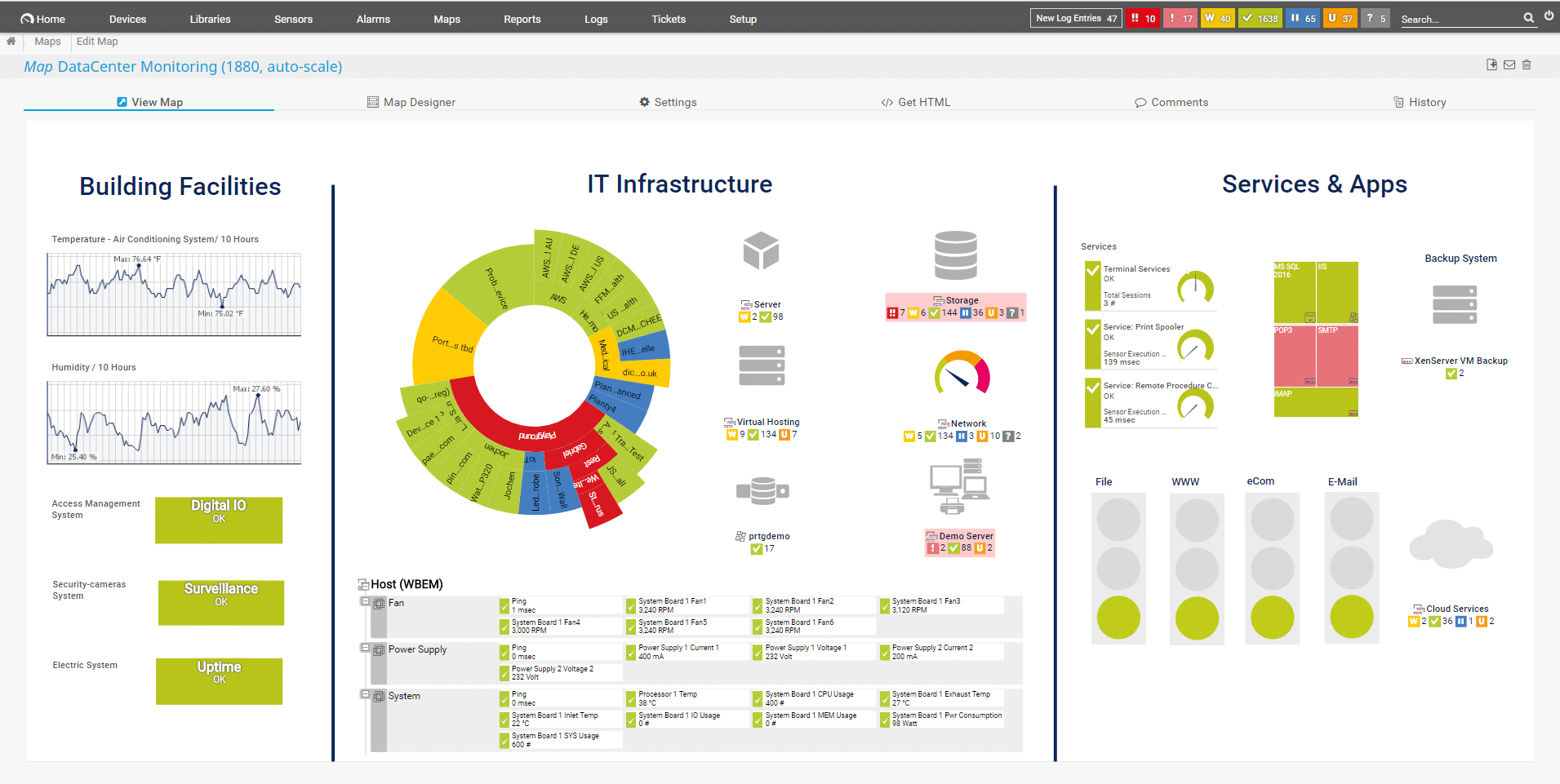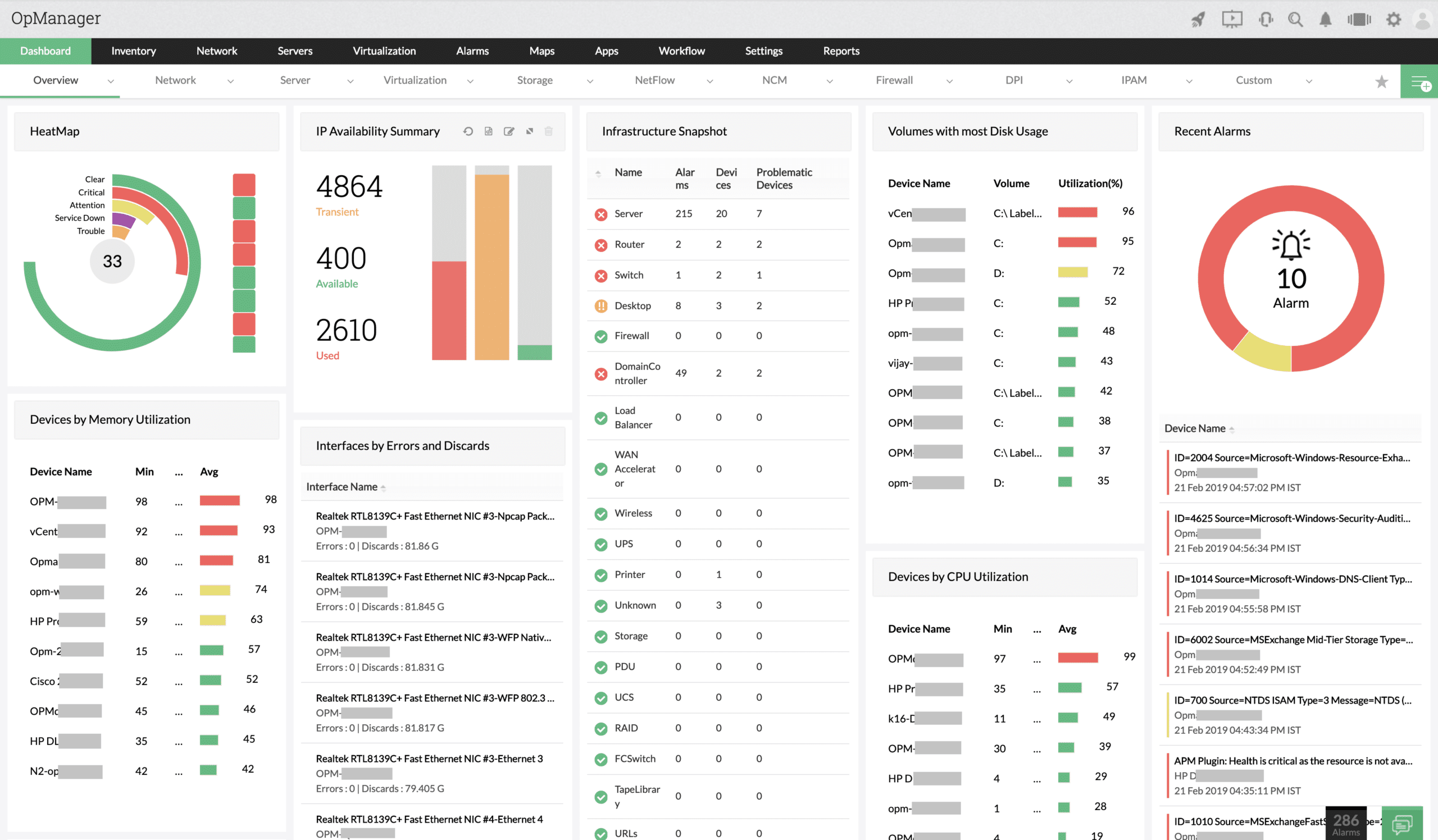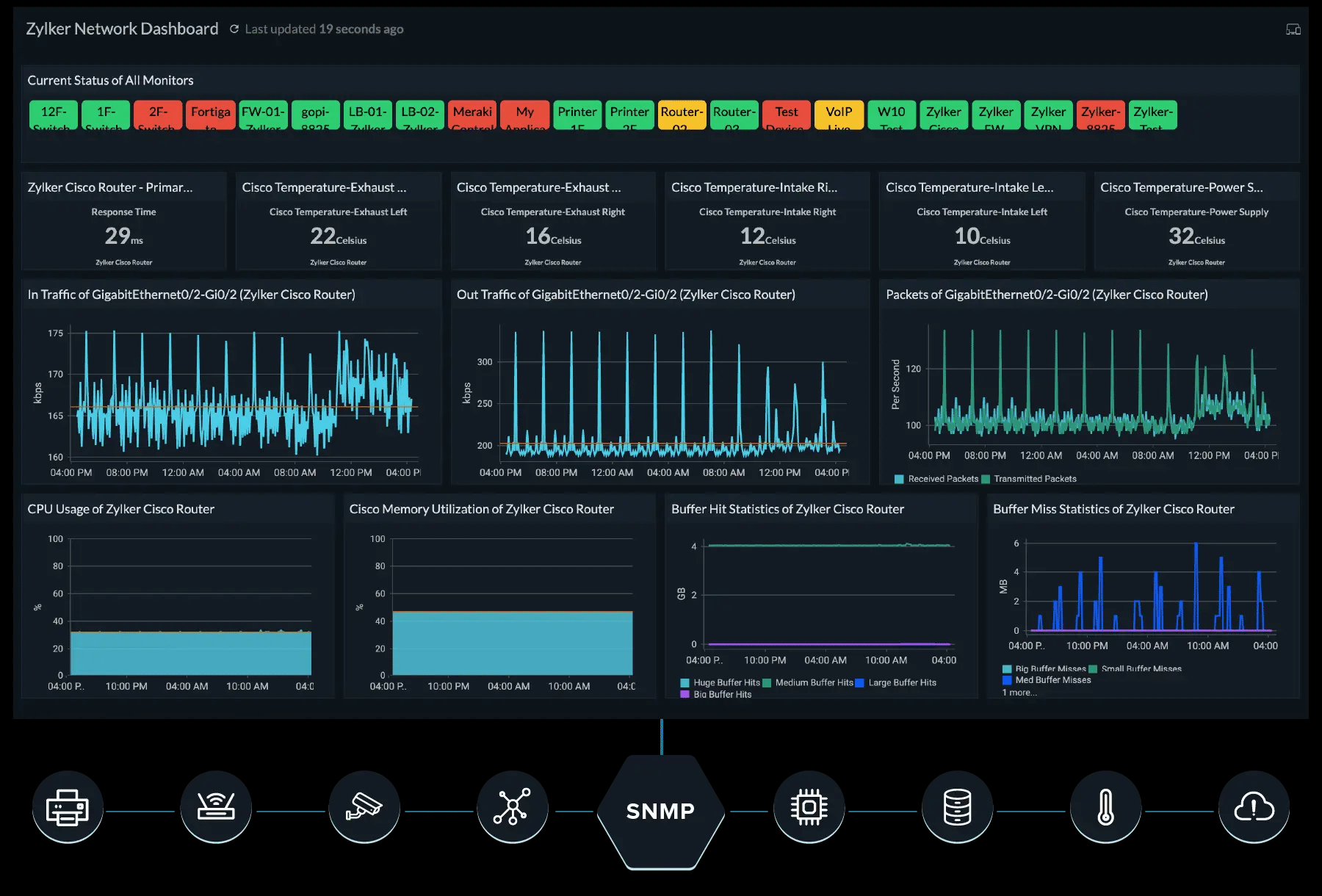Today's networks are complex and ever-growing. It can include hundreds and even thousands of different devices and endpoints, and this means, you need a holistic control and visibility into all that's happening within your network.
And this is not easy and not something that can be done manually. This is where advanced network monitoring tools come into play.
Here is our list of the best network device monitoring tools:
- Paessler PRTG – EDITOR'S CHOICE This flexible network monitoring tool uses sensors to monitor the different aspects of your network and alerts you in case of discrepancies and deviations. Download a 30-day free trial.
- ManageEngine OpManager – FREE TRIAL This affordable monitoring solution can monitor a wide variety of devices such as routers, firewalls, load balancers, servers, and more to provide a comprehensive understanding of your network's performance. Get a 30-day free trial.
- Site24X7 Network Monitoring – FREE TRIAL This is an agentless SaaS monitoring tool that helps you to have complete control over your entire IT infrastructure. Start a 30-day free trial.
- Auvik A cloud-based SaaS platform that provides device status monitoring with SNMP, traffic analysis with flow protocols, system discovery, and network configuration management.
- Datadog Network Monitoring This comprehensive monitoring platform provides in-depth visibility into the health of network devices, servers, connections, and other dependencies without your organization.
- SolarWinds Network Performance Monitor This multi-vendor network monitoring tool works well across different platforms. More importantly, it can scale and expand with your network's needs.
Benefits of Network Monitoring Tools
Besides providing control and visibility, here are some of the other benefits that come with using network monitoring tools.
- It helps to identify specific areas of your network that are experiencing problems.
- Eases the troubleshooting process.
- Optimizes the use of resources.
- Saves time and money.
- Reduces downtimes.
- Enhances compliance with industry standards.
- Helps with capacity planning.
- Discovering and fixing security threats, and more.
Now that you know the importance of network monitoring tools, let's take a look at some of the well-known tools that can provide all the above benefits and more!
Below are five of the best network monitoring tools available in the market today. We have evaluated them based on their capabilities, performance, and the potential value they can add to your business.
Our methodology for selecting the Best Network Monitoring Tool:
We've focused on these key criteria:
- Ability to monitor multi-vendor devices and provide comprehensive insights into network health and performance.
- Scalability to match the growing needs of businesses.
- Features such as availability monitoring, instant alerts, and detailed network analysis.
- Tools for visualizing network performance and relationships between devices.
- Ease of troubleshooting and capacity planning to enhance productivity and reduce downtime.
The Best Network Device Monitoring Tools
Let's now take a detailed look at each of these tools, so you can decide the best fit for your organization.
1. Paessler PRTG – FREE TRIAL
Paessler PRTG monitors all the systems, applications, and devices in your infrastructure using sensors, where each sensor monitors one aspect of your every device or application's performance. This way, you can scale up or down easily based on your business needs.
Key Features:
- Intuitive Maps and Dashboards: PRTG comes with intuitive maps and dashboards that provide real-time information in a way that you can understand. Its map designer comes with more than 300 different objects to depict devices, systems, applications, traffic, and more. You can use these components to provide a realistic view of your network. You can also use HTML to customize your map and can share it with others through a URL.
- Alerts: This platform sends alerts as soon as it detects any unusual metrics. Typically, it constantly compares the metrics with established thresholds and reports in case of any major deviations. This way, you're alerted to the problems right away. PRTG sends alerts through many channels such as email, HTTP, push notifications, and more.
- Works Well Across Devices: PRTG works well across multiple devices. Also, its web-based interface provides a uniform look and feel, regardless of the device on which you access it. Besides this, it also provides SSL-secured remote and local access. There are apps for iOS and Android as well.
- Failover Tolerance: A key feature of PRTG is failover tolerant monitoring. This means when the primary cluster master fails, another node takes over right away. So, there is no impact whatsoever on the systems or the notification-sending process.
- Remote Probes: PRTG supports distributed monitoring where you can use remote probes to monitor the different endpoints on your LAN. Note that every PRTG license comes with unlimited probes, so you can stay on top of your network's performance. If you're a Managed Service Provider (MSP), you can extend it to your clients' networks as well.
Why do we recommend it?
Paessler PRTG is recommended for its use of sensors to monitor various aspects of devices or applications, offering scalable monitoring solutions.
In all, PRTG is an efficient way of monitoring a network. Since it works well across multiple platforms and can be used to monitor varied aspects, it is highly useful in distributed environments.
Who is it recommended for?
Ideal for organizations looking for a comprehensive monitoring solution that provides granular insights into their IT infrastructure across various platforms and devices.
Pros:
- Comprehensive Monitoring: Uses a combination of packet sniffing, WMI, and SNMP to provide detailed insights into network performance and device discovery.
- Instant Autodiscovery: Automatically updates the inventory in real-time, reflecting any changes almost instantaneously.
- Customizable Views: The drag-and-drop editor allows for easy creation of custom dashboards and reports, tailored to your specific monitoring needs.
- Flexible Alerting: Supports a wide range of alert channels, including SMS, email, and third-party integrations, ensuring timely notifications.
- Freeware Version Available: Offers a free version, making it accessible for smaller businesses or those looking to test its capabilities before committing.
Cons:
- Steep Learning Curve: The platform’s extensive features and complex configuration options can require significant time to master.
The cost depends on the number of sensors you use. Typically, one sensor is used to monitor one aspect of a machine. For example, if you measure the memory and processing power of a single machine, that equals two sensors. Below is the pricing for the sensors you'd want to use.
- Up to 100 sensors – Free
- Up to 500 sensors – $1,799
- Up to 1000 sensors – $3,399
- Up to 2500 sensors – $6,899
- Up to 5000 sensors – $11,999
- Up to 10,000 sensors – $15,999
You can start with up to 100 sensors for free. Download a 30-day free trial.
EDITOR'S CHOICE
Paessler PRTG Network Monitor is our top pick for a network device monitoring tool because it offers an all-encompassing, user-friendly solution that covers the full range of network monitoring needs. PRTG allows administrators to keep a close eye on the performance and availability of network devices, ensuring minimal downtime and optimal functionality across the entire network infrastructure. What sets PRTG apart is its highly customizable sensor-based architecture, which allows for monitoring virtually any device, from routers and switches to servers and IoT devices. The tool provides real-time monitoring, ensuring that any performance issue or failure is immediately detected. Additionally, PRTG’s auto-discovery feature allows users to quickly identify and monitor new devices as they are added to the network. PRTG is also notable for its well-planned but customizable dashboard, which displays network status, traffic, and performance data in easily digestible charts and graphs. Alerts and notifications can be customized, so network administrators are instantly informed when thresholds are exceeded, ensuring that potential issues are addressed before they impact network performance. The tool’s scalability is another key benefit, as it can grow with the network, accommodating larger setups without compromising performance.
Download: Get a 30-day FREE Trial
Official Site: https://www.paessler.com/download/prtg-download?download=1
OS: Windows Server or SaaS
2. ManageEngine OpManager – FREE TRIAL
ManageEngine OpManager is a comprehensive monitoring tool that can stay on top of the health and performance of many types of devices such as routers, firewalls, servers, PCs, and more. The in-depth information collected from these devices provides a thorough understanding of your network's performance at any time.
Key Features:
- Monitors Servers Across Vendors: OpManager can monitor servers across multiple vendors and platforms. It works well on both physical and virtual servers that spread across multiple platforms such as Windows, Linux, VMware, and more. You can also monitor Hyper-V, Citrix XenServer, and other virtual machines. It works well on hybrid systems too.
- Enhances Fault Handling: This platform provides complete visibility into your network's performance, so it becomes easy to identify faults and fix them at the earliest. You can even set up first-level automation for troubleshooting and maintenance using OpManager. It even comes with a rule-based processing engine that can handle 300 SNMP traps per second. Its Syslog monitoring provides context through syslogs to help you perform the next steps in troubleshooting.
- Advanced Alerting Mechanism: Sends alerts about issues through SMS and email based on your preferences. This helps your employees to monitor problems in your network, regardless of their location. This platform also constantly monitors your network's parameters and reports any deviations. This way, you can know issues as they occur and fix them quickly.
- Integrations: Integrates well with many third-party tools to provide the flexibility and extensibility you need for your business. You can even extend OpManager to custom apps.
- Additional Features: Other than the above features, there are many additional functionalities that OpManager offers. Some of them include network configuration management, IP address management, firewall log management, application performance management, network traffic analysis, and more.
Why do we recommend it?
ManageEngine OpManager is recommended for its ability to monitor servers across multiple vendors and platforms, including both physical and virtual servers.
Overall, OpManager is a wide-arching platform that encompasses many aspects of your network monitoring. It is also highly flexible and extensible and can be adapted to suit your business needs.
Who is it recommended for?
Best for businesses of all sizes needing a versatile tool for monitoring various devices like routers, firewalls, and servers, with fault handling and advanced alerting mechanisms.
Pros:
- Freeware Version Available: Offers a free version, making it accessible for smaller organizations to test and use essential features.
- Comprehensive Monitoring: Utilizes both SNMP and NetFlow for extensive network and device monitoring, providing broader coverage than many other tools.
- Highly Scalable: Easily scales to support large networks, with the Enterprise package capable of monitoring up to 10,000 endpoints.
- Automatic Network Discovery: Automatically creates live inventories and network maps, helping administrators track assets and network growth in real-time.
- Versatile for All Network Sizes: Suitable for both small and large networks, making it a flexible choice for businesses of varying scales.
Cons:
- Steep Learning Curve: The platform’s extensive features, integrations, and customization options may require significant time and effort to fully master.
Get started with a 30-day free trial.
3. Site24x7 Network Monitoring Tool – FREE TRIAL
Site24x7 is an agentless and SaaS monitoring tool that provides all the insights you need at the device and interface levels. In turn, these insights provide the complete control you need over your network and overall IT infrastructure.
Key Features:
- Extensive Monitoring: Best known for its extensive monitoring capabilities, Site24x7 stays on top of the health and performance of your websites, servers, applications, cloud infrastructure, logs, networks, and more. It's also used to analyze the real-user app experience, so you can make the necessary changes to enhance the overall end-user experience. It works well across vendors and platforms.
- Optimizes Workloads: Provides insights into the usage of your cloud resources and the associated costs. Based on this information, it helps to optimize workloads for your infrastructure. Also, you have all the insights you need across hybrid and virtualization environments for improved optimization.
- Centralized Log Management: Implements a centralized log management system where you can connect all the dots to identify the likely causes for problems and outages. Plus, you can run queries on the logs to get the specific information you need quickly. Based on this information, you can set up alerts and do so much more.
- Additional Features: Besides the above features, Site24x7 also offers a ton of other things such as access through mobile apps so you can stay on top of your infrastructure's health on the go, generates extensive reports that can be used for internal auditing and compliance, helps with root-cause analysis, handles SLA management, and more.
Why do we recommend it?
Site24x7 is recommended for its extensive monitoring capabilities, covering networks, infrastructure, and real user experience in a single platform.
In all, Site24x7 is a comprehensive tool that stays on top of all aspects of your monitoring and through it, eases your decision-making process.
Who is it recommended for?
Ideal for businesses seeking a holistic monitoring solution that is user-friendly and capable of handling complex networks and infrastructures.
Pros:
- Holistic Monitoring Solution: Combines network, infrastructure, and real user monitoring into a single, comprehensive platform, making it one of the most all-encompassing tools available.
- Real-Time Data Utilization: Uses real-time data to automatically discover devices and generate charts, network maps, and inventory reports, ensuring up-to-date insights.
- User-Friendly Interface: Known for its intuitive design, making it accessible and easy to use, even for those new to network monitoring.
- Bridges Technical and Business Metrics: User monitoring capabilities help connect technical performance with user behavior and business outcomes, providing valuable insights.
- Freeware Version Available: Offers a free version, allowing users to test its features before committing to a paid plan.
Cons:
- Detailed and Complex: The platform is highly detailed with numerous features and options, requiring time and effort to fully understand and utilize all its capabilities.
Site24x7 offers four pricing plans:
- Starter: $9/month
- PRO: $35/month
- Classic: $89/month
- Enterprise: $225/month
Click here to sign up and start a 30-day free trial.
4. Auvik
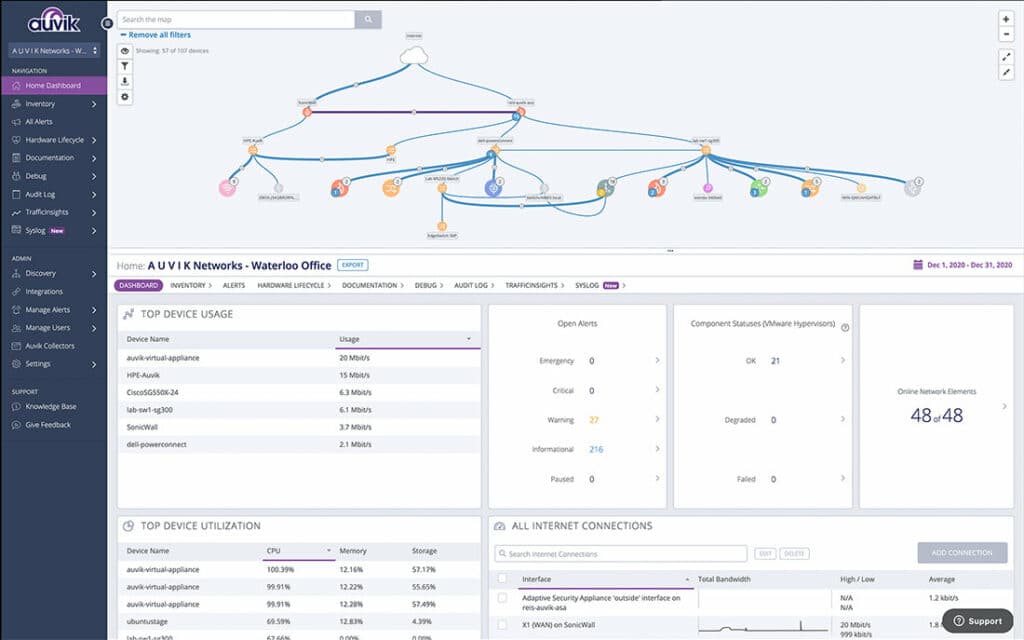
Auvik is a network monitoring tool. It is delivered from the cloud and implemented through the installation of a data collector on the local network. This system is a subscription service with a flat rate per client, regardless of the number of sites or devices to be monitored.
This tool includes an autodiscovery process. It assembles a network inventory from its discoveries and also draws up a network map. This discovery process is continuous, so any changes that you make to the network will immediately be reflected in the inventory and map.
Key Features:
- Autodiscovery: The service scans the network and identifies all of the devices that link it together and connect to it. The extracted data gets uploaded to the Auvik server where it is assembled into a hardware inventory. The device data includes details of the connections between them and that enables Auvik to draw up a network map. The tool will also show all the external connections from the network on a real-world map.
- Device Status Monitoring: The monitoring service cycles through a request and response routine that is based on the Simple Network Monitoring Protocol (SNMP). The Auvik collector acts as an SNMP manager that collects status reports from SNMP device agents. These reports detail the statuses of components along with other data about the device.
- Device Failure Alerts: The SNMP agent will send out a notification without waiting for a report request if it spots a component failure during its continuous device scans. These warnings are interpreted into alerts in the Auvik dashboard.
- Network Traffic Analysis: This service communicates with switches and routers using flow protocols. This process extracts traffic data per link and the information is uploaded to the Auvik cloud server for analysis. The tool can use NetFlow, IPFIX, sFlow, and J-Flow.
- Network Configuration Management: This service takes an image of the settings of each network device and stores it. This process repeats every 60 minutes and the Auvik service will take another copy if the xonfiguration has changed. Old configurations are not overwritten but each new copy is stored as a separate version. Configuration versions can be compared and the network administrator can choose to roll back to an earlier version.
Why do we recommend it?
Auvik is recommended for its robust network monitoring capabilities, particularly its continuous autodiscovery and real-time mapping features, which ensure that your network documentation is always up-to-date. Its cloud-based delivery and flat-rate subscription model make it highly scalable, ideal for organizations managing multiple sites or a large number of devices. Additionally, Auvik’s network configuration management and traffic analysis tools provide comprehensive oversight, helping IT teams quickly identify and resolve issues.
This package is particularly interesting for companies that run multiple sites. The subscription rates are levied per client without consideration for the number of devices or sites that will be monitored.
Who is it recommended for?
Auvik is ideal for IT administrators and network managers who oversee large, complex networks, especially those spread across multiple sites. It’s particularly beneficial for organizations that need continuous network visibility, real-time device status monitoring, and configuration management without worrying about scaling costs with increased devices or locations.
Pros:
- Continuous Network Discovery: Automatically identifies and maps all devices and connections in real-time, ensuring accurate network documentation.
- Real-Time Alerts: Provides instant alerts for device failures or traffic issues, enabling quick response to potential problems.
- Comprehensive Traffic Analysis: Uses flow protocols to analyze traffic patterns and detect irregularities, helping to optimize network performance.
- External Connection Mapping: Displays a real-world map of external network connections, offering a broader view of network interactions.
- Detailed Configuration Management: Regularly stores and tracks device configuration changes, allowing easy rollback to previous settings when needed.
Cons:
- Custom Pricing Required: Pricing details are not readily available and require contacting Auvik for a custom quote, which can be inconvenient for smaller businesses.
Auvik offers its network monitoring system on a 14-day free trial.
5. Datadog Network Monitoring
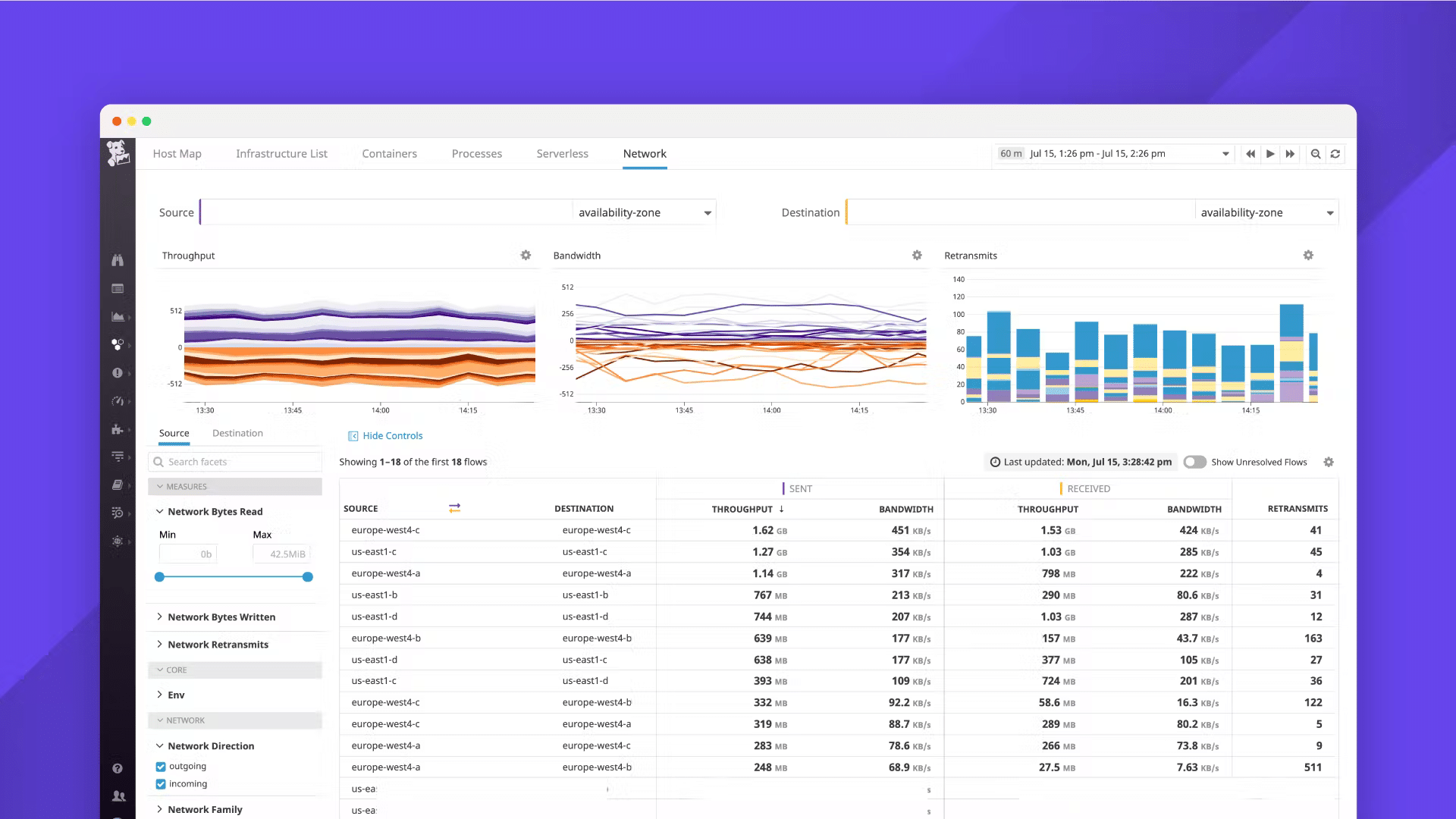
Datadog's network monitoring platform provides granular visibility into every aspect of your network, including the transactions, packet movement, and more. At the same time, it also aggregates all this data to give you wide visibility into the organization's operations.
Key Features:
- Optimizing Resources: Uses tags to classify all your resources, so you can sort and filter your metrics to find what you want. This way, you can access the information you need right away. Also, you will get a better understanding of how your resources are used and where are the leaks. Accordingly, you can plan for the capacity and optimize their use.
- Identify Misconfigurations: A key benefit of Datadog's network performance monitoring platform is its ability to identify misconfigurations. All that you have to do is simply head to the area of the problem, look through the configurations, and fix the misconfigured parameter. Likewise, it can also handle connectivity issues. For example, in a Kubernetes cluster, a single container can take up all the bandwidth. With Datadog, you can look at the images, identify the container, and make the necessary configuration changes to prevent this from happening.
- Monitors Everything: This comprehensive monitoring tool monitors almost every object in your network, including abstract ones. It checks on containers, individual hosts, services, applications, and more. It offers instant insights, so you can aggregate them to gain wide visibility into your network. Also, you can identify dependencies, and dig deep down to get the granular information you need for decision making.
- Integrations: Another great aspect of Datadog is that it integrates well with other apps and platforms, so you can extend it easily within your infrastructure. This way, you can correlate the logs of different applications to understand your network better.
Why do we recommend it?
Datadog Network Monitoring is recommended for its granular visibility into every aspect of a network, providing comprehensive monitoring and analytics.
Overall, Datadog is an advanced monitoring platform that integrates well into your existing infrastructure and at the same time, provides the insights you need for making the necessary decisions.
Who is it recommended for?
Best for businesses looking for an advanced monitoring platform that integrates well with existing infrastructure, offering insights for decision-making.
Pros:
- Comprehensive Real User Monitoring: Provides numerous templates and widgets for real user monitoring, allowing businesses to gain detailed insights into user behavior and network performance.
- Holistic Network Visibility: Monitors both internal and external aspects of the network, giving administrators a complete view of performance and accessibility.
- Real-Time Updates: Reflects changes made to the network in near real-time, ensuring that the latest data is always available for analysis and troubleshooting.
- Scalable Monitoring: Offers flexible pricing options that allow businesses to scale their monitoring efforts as needed, making it suitable for growing organizations.
Cons:
- Limited Trial Period: A longer trial period would be beneficial for users to fully explore and test the platform’s extensive features before committing to a purchase.
Click here for detailed pricing. Click here for a 14-day free trial.
6. SolarWinds Network Performance Monitor
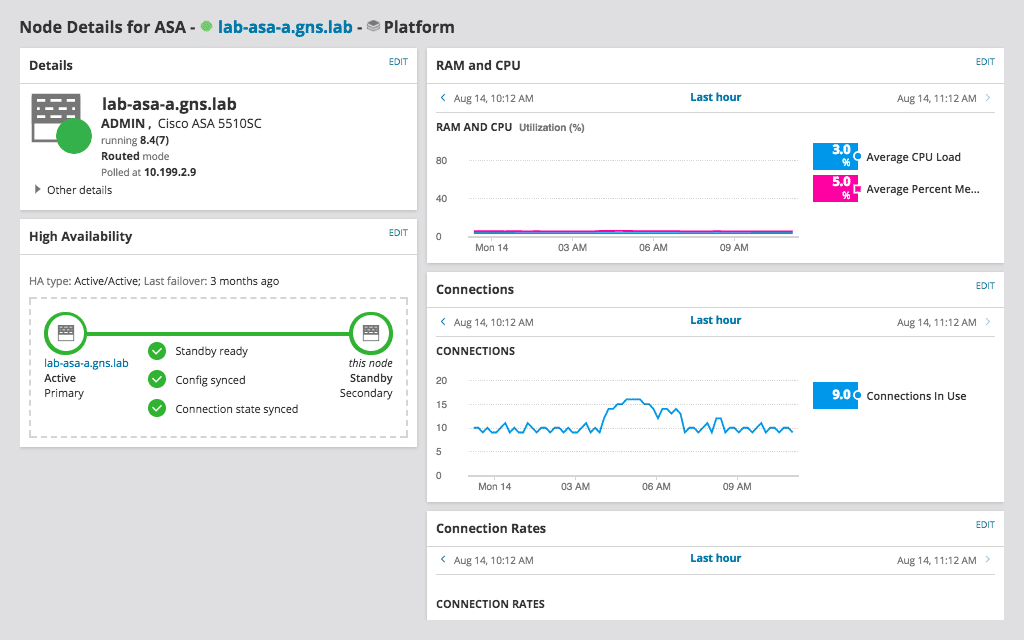
The SolarWinds Network Performance Monitor (NPM) is a comprehensive platform that can monitor multi-vendor devices and provide insights into their health and performance. It can also scale well with your growing business needs.
Key Features:
- Monitoring Availability: The most salient feature of SolarWinds NPM s its ability to collect detailed network metrics quickly. Using these metrics, you can easily identify the existing vulnerabilities and weak spots and can fix them right away. As a result, the chances for your downtime reduce greatly. In turn, this will enhance productivity within your organization and can also help you meet your Service Level Agreements (SLAs) with your clients. Furthermore, you can constantly monitor the performance and availability of your network and can take corrective action as needed.
- Instant Alerts: NPM compares the performance metrics of your network with established baseline values and alerts you when these metrics go beyond the threshold. It sends alerts through many channels, and you can choose the ones that are ideal for your communication practices. These alerts also contain the context of the problem, so it becomes easy to identify the root cause. Accordingly, you can fix the problem faster.
- Provides the Larger Picture: Earlier, we briefly talked about providing the context for the problem. SolarWinds' NPM does this using something called Orion Maps. This map specializes in mapping the physical and logical relationships among the different devices and entities, so you can isolate the cause quickly.
- Hop Analysis: NPM encompasses a tool called NetPath that detects the complete path a packet takes from its source to destination. This hop analysis identifies any network latency, dropped packets, bandwidth issues, and other potential problems in your network.
- Provides Visibility: Correlates multiple entities on a common timeline, so you get complete visibility of what's happening in your network. With this information, you can identify gaps easily and fix them before it starts to impact the wider organization.
Why do we recommend it?
SolarWinds Network Performance Monitor is recommended for its ability to quickly collect detailed network metrics, helping in identifying and fixing network vulnerabilities, thereby reducing downtime.
In all, SolarWinds NPM accelerates the identification of gaps and problems in your network and provides the context to fix the same easily. It also constantly stays on top of the health and performance of your network.
Who is it recommended for?
Ideal for IT professionals in medium to large organizations who need comprehensive monitoring of multi-vendor network devices with in-depth analysis and troubleshooting capabilities.
Pros:
- Holistic Network Monitoring: Provides a comprehensive view of server performance and health, covering multi-vendor devices across the entire network.
- Real-Time Auto-Discovery: Automatically builds network topology maps and updates inventory lists in real-time as new devices are detected.
- Versatile Monitoring Options: Supports both SNMP monitoring and packet analysis, offering greater control over network monitoring compared to similar tools.
- Customizable Dashboard: Features a drag-and-drop interface for customizing the dashboard, allowing users to tailor the layout to their specific needs.
- Robust Reporting: Includes a powerful reporting system with pre-configured templates for compliance and other essential metrics.
Cons:
- Complex for Non-Technical Users: The platform is designed with IT professionals in mind, making it less accessible for users without technical expertise.
NPM's pricing starts from $1,638. Click here for a 30-day free trial.
Bottomline
To conclude, network device monitoring tools are key to ensuring that your network and all the devices and applications that work on it are in good health and perform optimally. These tools point out any deviations or issues in any device, so you can fix them at the earliest. Further, the insights offered by these tools come in handy for making decisions.
We hope this was a useful read for you. Click here to read more such guides.

